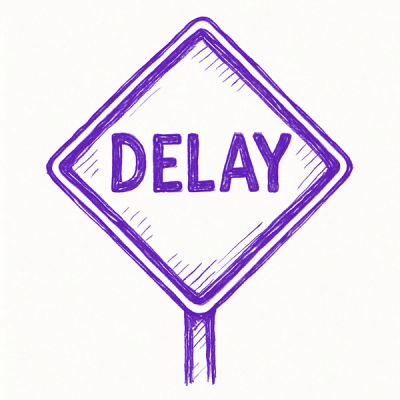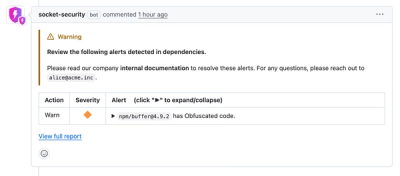
Security News
pnpm 10.16 Adds New Setting for Delayed Dependency Updates
pnpm's new minimumReleaseAge setting delays package updates to prevent supply chain attacks, with other tools like Taze and NCU following suit.
eeg-eyetracking-parser
Advanced tools
A Python module for reading concurrently recorded EEG and eye-tracking data,
Copyright (2022-2025) Hermine Berberyan, Wouter Kruijne, Sebastiaan Mathôt, Ana Vilotijević
A Python module for reading concurrently recorded EEG and eye-tracking data, and parsing this data into convenient objects for further analysis. For this to work, several assumptions need to be met, as described under Assumptions. At present, this module is largely for internal use, and focused on our own recording environment.
Key features:
Parse the data.
import eeg_eyetracking_parser as eet
# eet.read_subject.clear() # uncomment to clear the cache and reparse
raw, events, metadata = eet.read_subject(2)
raw.plot()
To avoid having to parse the data over and over again, read_subject() uses persistent memoization, which is a way to store the return values of a function on disk and return them right away on subsequent calls. To clear the memoization cache, either call the read_subject.clear() function or remove the .memoize folder.
Plot the voltage across four occipital electrodes locked to cue onset for three seconds. This is done separately for three different conditions, defined by cue_eccentricity. The function eet.autoreject_epochs() behaves similarly to mne.Epochs(), except that autorejection is applied and that, like read_subject(), it uses persistent memoization.
import numpy as np
import mne
from matplotlib import pyplot as plt
from datamatrix import convert as cnv
CUE_TRIGGER = 1
CHANNELS = 'O1', 'O2', 'Oz', 'P3', 'P4'
cue_epoch = eet.autoreject_epochs(raw, eet.epoch_trigger(events, CUE_TRIGGER),
tmin=-.1, tmax=3, metadata=metadata,
picks=CHANNELS)
We can convert the metadata, which is a DataFrame, to a DataMatrix, and add cue_epoch as a multidimensional column
from datamatrix import convert as cnv
import time_series_test as tst
dm = cnv.from_pandas(metadata)
dm.erp = cnv.from_mne_epochs(cue_epoch) # rows x channel x time
dm.mean_erp = dm.erp[:, ...] # Average over channels: rows x time
tst.plot(dm, dv='mean_erp', hue_factor='cue_eccentricity')
Because the regular mne.Epoch() object doesn't play nice with non-data channels, such as pupil size, you need to use the eet.PupilEpochs() class instead. This is class otherwise identical, except that it by default removes trials where baseline pupil size is more than 2 SD from the mean baseline pupil size.
pupil_cue_epoch = eet.PupilEpochs(raw, eet.epoch_trigger(events, CUE_TRIGGER),
tmin=0, tmax=3, metadata=metadata,
baseline=(0, .05))
dm.pupil = cnv.from_mne_epochs(pupil_cue_epoch, ch_avg=True) # only 1 channel
tst.plot(dm, dv='pupil', hue_factor='cue_eccentricity')
pip install eeg_eyetracking_parser
.vhdr), recorded at 1000 Hz.edf), recorded monocularly at 1000 HzFiles should be organized following BIDS.
# Container folder for all data
data/
# Subject 2
sub-02/
# EEG data
eeg/
sub-02_task-attentionalbreadth_eeg.eeg
sub-02_task-attentionalbreadth_eeg.vhdr
sub-02_task-attentionalbreadth_eeg.vmrk
# Behavioral data (usually not necessary)
beh/
sub-02_task-attentionalbreadth_beh.csv
# Eye-tracking data
eyetracking/
sub-02_task-attentionalbreadth_physio.edf
You can re-organize data files into the above structure automatically with the data2bids command, which is part of this package.
Assumptions:
For example, to re-organize from participants 1, 2, 3, and 4 for a task called 'attentional-breadth', you can run the following command. This assumes that the unorganized files are in a subfolder called data and that the re-organized (BIDS-compatible) files are also in this subfolder, i.e. as shown above.
data2bids --source-path=data --target-path=data -s=1,2,3,4 -t=attentional-breadth
The start of each trial is indicated by a counter that starts at 128 for the first trial, and wraps around after 255, such that trial 129 is indicated again by 128. This trigger does not need to be sent to the eye tracker, which uses its own start_trial message. A temporal offset between the start_trial message of the eye tracker and the start-trial trigger of the EEG is ok, and will be compensated for during parsing.
EE.PulseLines(128 + trialid % 128, 10) # EE is the EventExchange object
The onset of each epoch is indicated by a counter that starts at 1 for the first epoch, and then increases for subsequent epochs. In other words, if the target presentation is the second epoch of the trial, then this would correspond to trigger 2 as in the example below. This trigger needs to be sent to both the EEG and the eye tracker at the exact same moment (a temporal offset is not ok).
target_trigger = 2
eyetracker.log(f'start_phase {target_trigger}') # eyetracker is created by PyGaze
EE.PulseLines(target_trigger, 10)
Triggers should only be used for temporal information. Conditions are only logged in the eye-tracking data.
A factory function that creates an Epochs() object, applies autorejection, and then returns it.
Important: This function uses persistent memoization, which means that the results for a given set of arguments are stored on disk and returned right away for subsequent calls. For more information, see https://pydatamatrix.eu/memoization/
*args: iterable
Arguments passed to mne.Epochs()
ar_kwargs: dict or None, optional
Keywords to be passed to AutoReject(). If n_interpolate is not
specified, a default value of [1, 4, 8, 16] is used.
**kwargs: dict
Keywords passed to mne.Epochs()
Epochs:
An mne.Epochs() object with autorejection applied.
Selects a single epoch trigger from a tuple with event information. Epoch triggers have values between 1 and 127 (inclusive).
events: tuple
Event information as returned by read_subject().
trigger: int
A trigger code, which is a positive value.
array:
A numpy array with events as expected by mne.Epochs().
An Epochs class for the PupilSize channel. This allows baseline correction to be applied to pupil size, even though this channel is not a regular data channel. In addition, this class allows pupil sizes to be excluded based on deviant baseline values, which is recommended for pupil analysis (but not typically done for eeg).
*args: iterable
Arguments passed to mne.Epochs()
baseline_trim: tuple of int, optional
The range of acceptable baseline values. This refers to z-scores.
channel: str, optional
The channel name that contains pupil-size data
**kwargs: dict
Keywords passed to mne.Epochs()
Epochs:
An mne.Epochs() object with autorejection applied.
Reads EEG, eye-tracking, and behavioral data for a single participant. This data should be organized according to the BIDS specification.
EEG data is assumed to be in BrainVision data format (.vhdr, .vmrk,
.eeg). Eye-tracking data is assumed to be in EyeLink data format (.edf
or .asc). Behavioral data is assumed to be in .csv format.
Metadata is taken from the behavioral .csv file if present, and from
the eye-tracking data if not.
Important: This function uses persistent memoization, which means that the results for a given set of arguments are stored on disk and returned right away for subsequent calls. For more information, see https://pydatamatrix.eu/memoization/
subject_nr: int or sr
The subject number to parse. If an int is passed, the subject number is assumed to be zero-padded to length two (e.g. '01'). If a string is passed, the string is used directly.
folder: str, optional
The folder in which the data is stored.
trigger_parser: callable, optional
A function that converts annotations to events. If no function is specified, triggers are assumed to be encoded by the OpenVibe acquisition software and to follow the convention for indicating trial numbers and event onsets as described in the readme.
eeg_margin: int, optional
The number of seconds after the last trigger to keep. The rest of the data will be cropped to save memory (in case long periods of extraneous data were recorded).
min_sacc_dur: int, optional
The minimum duration of a saccade before it is annotated as a BAD_SACCADE.
min_sacc_size: int, optional
The minimum size of a saccade (in pixels) before it is annotated as a saccade.
min_blink_dur: int, optional
The minimum duration of a blink before it is annotated as a blink.
blink_annotation: str, optional
The annotation label to be used for blinks. Use a BAD_ suffix to use blinks a bads annotations.
saccade_annotation: str, optional
The annotation label to be used for saccades. Use a BAD_ suffix to use saccades a bads annotations.
eeg_preprocessing: bool or list, optional
Indicates whether EEG preprocessing should be performed. If True,
then all preprocessing steps are performed. If a list is passed, then
only those steps are performed for which the corresponding function
name is in the list (e.g. ['downsample_data', 'set_montage'])
save_preprocessing_output: bool, optional
Indicates whether output generated during EEG preprocessing should be saved.
plot_preprocessing: bool, optional
Indicates whether plots should be shown during EEG preprocessing.
eye_kwargs: dict, optional
Optional keyword arguments to be passed onto the EyeLink parser. If traceprocessor is provided, a default traceprocessor is used with advanced blink reconstruction enabled and 10x downsampling.
downsample_data_kwargs: dict, optional
Passed as keyword arguments to corresponding preprocessing function.
drop_unused_channels_kwargs: dict, optional
Passed as keyword arguments to corresponding preprocessing function.
rereference_channels_kwargs: dict, optional
Passed as keyword arguments to corresponding preprocessing function.
create_eog_channels_kwargs: dict, optional
Passed as keyword arguments to corresponding preprocessing function.
set_montage_kwargs: dict, optional
Passed as keyword arguments to corresponding preprocessing function.
annotate_emg_kwargs: dict, optional
Passed as keyword arguments to corresponding preprocessing function.
band_pass_filter_kwargs: dict, optional
Passed as keyword arguments to corresponding preprocessing function.
autodetect_bad_channels_kwargs: dict, optional
Passed as keyword arguments to corresponding preprocessing function.
run_ica_kwargs: dict, optional
Passed as keyword arguments to corresponding preprocessing function.
auto_select_ica_kwargs: dict, optional
Passed as keyword arguments to corresponding preprocessing function.
interpolate_bads_kwargs: dict, optional
Passed as keyword arguments to corresponding preprocessing function.
tuple:
A raw (EEG data), events (EEG triggers), metadata (a table with experimental variables) tuple.
Selects all trial triggers from event information. Trial triggers have values between 128 and 255 (inclusive).
events: tuple
Event information as returned by read_subject().
array:
A numpy array with events as expected by mne.Epochs().
The main entry point for decoding a subject's data.
read_subject_kwargs: dict
A dict with keyword arguments that are passed to eet.read_subject() to
load the data. Additional preprocessing as specified in
preprocess_raw() is applied afterwards.
factors: str or list of str
A factor or list of factors that should be decoded. Factors should be str and match column names in the metadata.
epochs_kwargs: dict, optional
A dict with keyword arguments that are passed to mne.Epochs() to extract the to-be-decoded epoch.
trigger: int
The trigger code that defines the to-be-decoded epoch.
epochs_query: str, optional
A pandas-style query to select trials from the to-be-decoded epoch. The
default assumes that there is a practice column from which we only
want to have the 'no' values, i.e. that we want exclude practice
trials.
epochs: int, optional
The number of training epochs, i.e. the number of times that the data is fed into the model. This should be at least 2.
window_size_samples: int, optional
The length of the window to sample from the Epochs object. This should be slightly shorter than the actual Epochs to allow for jittered samples to be taken from the purpose of 'cropped decoding'.
window_stride_samples: int, optional
The number of samples to jitter around the window for the purpose of cropped decoding.
n_fold: int, optional
The total number of splits (or folds). This should be at least 2.
crossdecode_read_subject_kwargs: dict or None, optional
When provided these read_subject_kwargs are passed to read_subject_func for reading the to-be-decoded test dataset.
crossdecode_factors: str or list of str or None, optional
A factor or list of factors that should be decoded during tester. If
provided, the classifier is trained using the factors specified in
factors and tested using the factors specified in
crossdecode_factors. In other words, specifying this keyword allow
for crossdecoding.
patch_data_func: callable or None, optional
If provided, this should be a function that accepts a tuple of
(raw, events, metadata) as returned by read_subject() and also
returns a tuple of (raw, events, metadata). This function can modify
aspects of the data before decoding is applied.
read_subject_func: callable or None, optional
If provided, this should be a function that accepts keywords as
provided through the read_subject_kwargs argument, and returns a
tuple of (raw, events, metadata). If not provided, the default
read_subject() function is used.
cuda: bool, optional
If True, cuda will be used for GPU processing if it is available. If False, cuda won't be used, not even when it is available.
balance: bool, optional
Makes sure that a dataset contains an equal number of observations for each label by randomly duplicating observations from labels that have too few observations.
DataMatrix
Contains the original metadata plus four additional columns:
braindecode_label is a numeric label that corresponds to the
to-be-decoded factor, i.e. the ground truthbraindecode_prediction is the predicted labelbraindecode_correct is 1 for correct predictions and 0 otherwisebraindecode_probabilities is a SeriesColumn with the predicted
probabilities for each label. The prediction itself corresponds to
the index with the highest probability.eeg_eyetracking_parser is licensed under the GNU General Public License
v3.
FAQs
A Python module for reading concurrently recorded EEG and eye-tracking data,
We found that eeg-eyetracking-parser demonstrated a healthy version release cadence and project activity because the last version was released less than a year ago. It has 1 open source maintainer collaborating on the project.
Did you know?

Socket for GitHub automatically highlights issues in each pull request and monitors the health of all your open source dependencies. Discover the contents of your packages and block harmful activity before you install or update your dependencies.

Security News
pnpm's new minimumReleaseAge setting delays package updates to prevent supply chain attacks, with other tools like Taze and NCU following suit.

Security News
The Rust Security Response WG is warning of phishing emails from rustfoundation.dev targeting crates.io users.

Product
Socket now lets you customize pull request alert headers, helping security teams share clear guidance right in PRs to speed reviews and reduce back-and-forth.